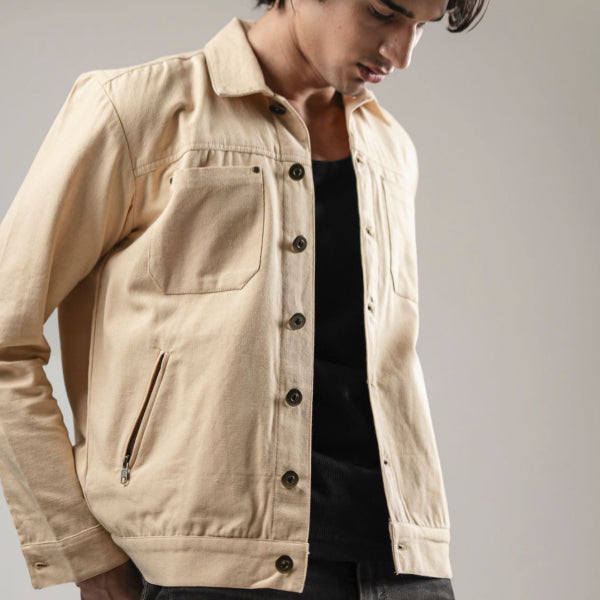Tough, versatile, and unmistakably rugged—cotton canvas is a fabric that has stood the test of time. From army tents and artist canvases to utility jackets and backpacks, this humble heavyweight fabric has quietly supported humanity through centuries of work, travel, and exploration.
But cotton canvas isn’t just utilitarian anymore. Today, it’s being rediscovered as a stylish, sustainable, and hard-wearing material for outerwear and accessories. So what exactly makes cotton canvas so special? Where did it come from, how is it made, and why is it such a smart choice for slow fashion?
Let’s dive into the world of canvas and unpack why it continues to be a favourite among designers, adventurers, and conscious consumers alike.
A Brief History of Cotton Canvas
The word canvas comes from the Latin cannabis, as early canvas was made from hemp. Over time, cotton became the preferred fibre, especially for more refined or wearable uses. Historically, canvas was used for:
-
Sails on ships during the Age of Exploration
-
Military tents, duffel bags, and uniforms
-
Painting surfaces for Renaissance artists
-
Workwear and protective gear in factories and farms
Its enduring use is a testament to its reliability and strength.
What Is Cotton Canvas?
Cotton canvas is a plain-woven fabric, traditionally made from 100% cotton yarns. What sets it apart from other cotton fabrics is its tight weave and heavy weight, which give it:
-
High durability
-
Excellent wind resistance
-
Abrasion resistance
-
Shape retention
Canvas is often categorised by weight—measured in ounces per square yard. Lightweight canvas (7–10 oz) is suitable for jackets and bags, while heavyweight canvas (12 oz and above) is ideal for outdoor gear and upholstery.
How Is It Made?
-
Cotton Harvesting: Raw cotton fibres are harvested and cleaned.
-
Spinning: Fibres are spun into thick, sturdy yarns.
-
Weaving: These yarns are tightly woven in a plain weave (one-over, one-under pattern).
-
Finishing: Canvas may be pre-shrunk, dyed, waxed, or treated depending on the end use.
Canvas can be left raw for a natural look or given a smooth finish using calendaring (pressing) or coating (e.g., waxed canvas for water resistance).
Why Cotton Canvas Stands Out
1. Built to Last
Canvas is exceptionally long-lasting. It resists wear and tear far better than most woven cottons and holds up well over time, even with frequent use.
2. Holds Its Shape
Canvas has a crisp structure, giving jackets and bags a defined silhouette. It doesn’t sag or drape like softer fabrics—making it ideal for rugged styling.
3. Breathable, Natural, and Biodegradable
Unlike synthetics, cotton canvas is breathable and naturally hypoallergenic. It’s made from a renewable resource and breaks down over time, making it more eco-friendly.
4. Takes Dye Beautifully
Its dense weave absorbs dyes deeply, giving canvas garments rich, saturated tones that don’t fade easily.
5. Easy to Maintain
With simple spot cleaning and occasional washes, canvas garments age gracefully—earning character with every wear.

Modern Uses in Fashion
Designers are now embracing canvas as a hero fabric in slow fashion. You’ll find it in:
-
Utility jackets with sharp lines and sturdy collars
-
Work shirts built for durability and structure
-
Overshirts and chore coats that blend function with form
-
Tote bags and backpacks that can handle the everyday hustle
Canvas vs. Other Cotton Fabrics
| Fabric Type | Weave | Texture | Durability | Best Used For |
|---|---|---|---|---|
| Cotton Voile | Plain weave | Soft, sheer | Low | Summer tops, linings |
| Cotton Twill | Diagonal weave | Smooth, drapey | Medium | Trousers, jackets |
| Cotton Canvas | Plain weave | Firm, structured | High | Outerwear, bags, aprons |
Why It Fits Slow Fashion
Cotton canvas is made for clothing that’s meant to last—not follow fads. Its longevity, recyclability, and timeless appeal make it ideal for brands that value quality over quantity.
Choosing a canvas piece means choosing:
-
Fewer but better garments
-
Reduced consumption and waste
-
A more intentional, rugged aesthetic
Cotton canvas might not be flashy, but it doesn’t need to be. Its strength is in its story—woven into sails, stitched into history, and now tailored into garments that serve both purpose and style.
Whether you’re wearing a canvas overshirt or carrying a sturdy tote, you’re part of a lineage of makers, explorers, and rebels who chose substance over superficiality.
So go ahead—wear it rough, wear it proud. That’s what canvas was made for.





Share:
The Slow Fashion Manifesto
Natural vs Synthetic Fabrics: What to Wear in the Indian Climate